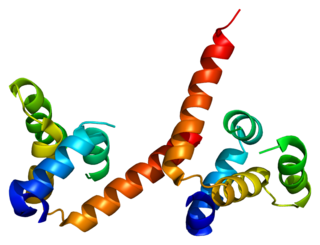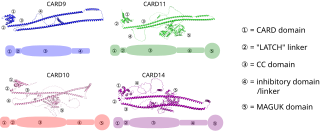
Caspases are a family of protease enzymes playing essential roles in programmed cell death. They are named caspases due to their specific cysteine protease activity – a cysteine in its active site nucleophilically attacks and cleaves a target protein only after an aspartic acid residue. As of 2009, there are 12 confirmed caspases in humans and 10 in mice, carrying out a variety of cellular functions.

NLR family pyrin domain containing 3 (NLRP3), is a protein that in humans is encoded by the NLRP3 gene located on the long arm of chromosome 1.
Pyroptosis is a highly inflammatory form of lytic programmed cell death that occurs most frequently upon infection with intracellular pathogens and is likely to form part of the antimicrobial response. This process promotes the rapid clearance of various bacterial, viral, fungal and protozoan infections by removing intracellular replication niches and enhancing the host's defensive responses. Pyroptosis can take place in immune cells and is also reported to occur in keratinocytes and some epithelial cells.

Caspase-8 is a caspase protein, encoded by the CASP8 gene. It most likely acts upon caspase-3. CASP8 orthologs have been identified in numerous mammals for which complete genome data are available. These unique orthologs are also present in birds.

Caspase-6 is an enzyme that in humans is encoded by the CASP6 gene. CASP6 orthologs have been identified in numerous mammals for which complete genome data are available. Unique orthologs are also present in birds, lizards, lissamphibians, and teleosts. Caspase-6 has known functions in apoptosis, early immune response and neurodegeneration in Huntington's and Alzheimer's disease.

B-cell lymphoma/leukemia 10 is a protein that in humans is encoded by the BCL10 gene. Like BCL2, BCL3, BCL5, BCL6, BCL7A, and BCL9, it has clinical significance in lymphoma.

Tumor necrosis factor, alpha-induced protein 3 or A20 is a protein that in humans is encoded by the TNFAIP3 gene.

Receptor-interacting serine/threonine-protein kinase 2 is an enzyme that in humans is encoded by the RIPK2 gene.

Caspase recruitment domain-containing protein 11 also known as CARD-containing MAGUK protein 1 is a protein in the CARD-CC protein family that in humans is encoded by the CARD11 gene. CARD 11 is a membrane associated protein that is found in various human tissues, including the thymus, spleen, liver, and peripheral blood leukocytes. Similarly, CARD 11 is also found in abundance in various lines of cancer cells.

Mitochondrial antiviral-signaling protein (MAVS) is a protein that is essential for antiviral innate immunity. MAVS is located in the outer membrane of the mitochondria, peroxisomes, and mitochondrial-associated endoplasmic reticulum membrane (MAM). Upon viral infection, a group of cytosolic proteins will detect the presence of the virus and bind to MAVS, thereby activating MAVS. The activation of MAVS leads the virally infected cell to secrete cytokines. This induces an immune response which kills the host's virally infected cells, resulting in clearance of the virus.

Caspase recruitment domain-containing protein 10 is a protein in the CARD-CC protein family that in humans is encoded by the CARD10 gene.

Mucosa-associated lymphoid tissue lymphoma translocation protein 1 is a protein that in humans is encoded by the MALT1 gene. It's the human paracaspase.

NACHT, LRR and PYD domains-containing protein 4 is a protein that in humans is encoded by the NLRP4 gene.

The nucleotide-binding oligomerization domain-like receptors, or NOD-like receptors (NLRs), are intracellular sensors of pathogen-associated molecular patterns (PAMPs) that enter the cell via phagocytosis or pores, and damage-associated molecular patterns (DAMPs) that are associated with cell stress. They are types of pattern recognition receptors (PRRs), and play key roles in the regulation of innate immune response. NLRs can cooperate with toll-like receptors (TLRs) and regulate inflammatory and apoptotic response.

Inflammasomes are cytosolic multiprotein oligomers of the innate immune system responsible for the activation of inflammatory responses. Activation and assembly of the inflammasome promotes proteolytic cleavage, maturation and secretion of pro-inflammatory cytokines interleukin 1β (IL-1β) and interleukin 18 (IL-18), as well as cleavage of gasdermin D. The N-terminal fragment resulting from this cleavage induces a pro-inflammatory form of programmed cell death distinct from apoptosis, referred to as pyroptosis, and is responsible for secretion of the mature cytokines, presumably through the formation of pores in the plasma membrane. Additionally, inflammasomes can be incorporated into larger cell death-inducing complexes called PANoptosomes, which drive another distinct form of pro-inflammatory cell death called PANoptosis.

Caspase recruitment domain-containing protein 14, also known as D-containing MAGUK protein 2, is a protein in the CARD-CC protein family that in humans is encoded by the CARD14 gene.

Bcl10-interacting CARD protein, also known as BinCARD, is a protein that in humans is encoded by the C9orf89 gene on chromosome 9. BinCARD is a member of the death-domain superfamily and contains a caspase recruitment domain (CARD). This protein regulates apoptosis and the immune response by inhibiting Bcl10, thus implicating it in diseases stemming from Bcl10 dysfunction.

The CARD-CC protein family is defined by an evolutionary conserved "caspase activation and recruitment domain" (CARD) and a coiled-coil (CC) domain. Coiled-coils (CC) act as oligomerization domains for many proteins such as structural and motor proteins, and transcription factors. This means that monomers are converted to macromolecular complexes by polymerization. In humans and other jawed vertebrates, the family consists of CARD9 and the three "CARD-containing MAGUK protein" (CARMA) proteins CARD11 (CARMA1), CARD14 (CARMA2) and CARD10 (CARMA3). Although the MAGUK protein DLG5 contains both a CARD domain and a CC domain, it does not belong to the same family as the CARD-CC proteins since the evolutionary origin of its CARD domain is very likely to be different.

Vishva Mitra Dixit is a physician of Indian origin who is the current Vice President of Discovery Research at Genentech.
Autoinflammatory diseases (AIDs) are a group of rare disorders caused by dysfunction of the innate immune system. They are characterized by periodic or chronic systemic inflammation, usually without the involvement of adaptive immunity.





















